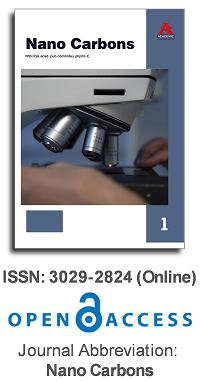

Description
Nano Carbons is a prestigious open access, peer-reviewed journal that delves into the multifaceted world of nanocarbon research. It serves as a platform for scholars and researchers to share their findings and insights across a broad spectrum of topics related to nanocarbon. It publishes various article types including Original Research Articles, Reviews, Editorials, and Perspectives, all of which undergo a rigorous peer-review process to ensure the dissemination of high-quality, cutting-edge knowledge. In addition, the journal emphasizes interdisciplinary research and encourages the integration of nanocarbon with fields such as biomedicine and industry.
Nano Carbons is a comprehensive journal that caters to the scientific community interested in the latest advancements in nanocarbon science and technology, providing a forum for the exchange of ideas and the promotion of interdisciplinary collaboration.
Latest Articles
-
 Open Access
Open AccessArticle
Article ID: 2491
Cumulative quantum mechanics and the method of generalized mathematical transfer for describing the interaction of an electric field with matter in nanostructures of chemically doped diamondby Philipp Vysikaylo
Nano Carbons, Vol.3, No.1, 2025;
We analytically (based on cumulative quantum mechanics (CQM) and the method of generalized mathematical transfer (MGMT)) study quantum nanometer cumulative-dissipative structures (CDS) and the forces arising in them, focusing nanostructures into regular, fractalized systems—cumulative dissipative standing hydrogen-like excitons (hydrogen-like atoms, molecules, lines, surfaces) and flickering crystals discovered by the author. The CQM turned out to be useful in describing “mysterious” CDS with sizes of 10−15–1026 m. In CDS, cumulation and dissipation of masses, energies, momenta and fields occur simultaneously (or with a certain delay) and in accordance with fairly general laws (the virial theorem works). Using the CQM and MGMT, in this paper we describe cumulative and dissipative phenomena in diamonds doped with boron (atoms from group Ⅲ of the periodic table). Problems in crystals with chemical doping with foreign atoms (with their introduction into the crystal lattice) were solved. We: (1) discovered the Vysikaylo’s standing excitons formed on inhomogeneities of the permittivity −ε(r) in diamond in the nanoregion of a foreign atom; (2) for the first time we solved the problem of measuring the ε(r) profiles in inhomogeneous nanoscale structures using Raman spectra (RS) (with an accuracy of up to 99.9% of ε(r) and a step of up to 0.3 nm depending on the distance from the impurity atom (boron)); (3) based on our theory of the Vysikaylo’s standing excitons, we prove the observation in the experiments described in the literature of degeneracy of the electron spectra in standing excitons with respect to the principal quantum number n and n-1/2. Comparing the theory and experimental observations of RS in diamonds doped with boron, we solve (formulated by us earlier) the problem between the de Broglie hypothesis and the classical new quantum mechanics of Dirac (which limits the ψ-functions-prohibits symmetric de Broglie half-waves in spherically and cylindrically symmetric quantum hollow resonators) in favor of the de Broglie hypothesis. Based on the works of Vanier and Mott, we have refined the definition of the permittivity of nanocrystals as a coefficient in electric potentials (U(r) → ε(r)U(r)), rather than electric fields (D(r) = ε(r)E(r)). We have constructed the most complete theory of chemical doping of crystals (using the example of crystals of group IV elements with atoms of groups Ⅲ and V from the periodic table. For the first time, the question of quantum cleaning of crystals or cumulation of dopant atoms to each other has been raised.
show more -
 Open Access
Open AccessReview
Article ID: 1254
Recent progress in Nanomaterial based biosensors for the detection of cancer biomarkers in human fluidsby Razu Shahazi, Amirul Islam Saddam, Md Rakibul Islam, Mohammed Muzibur Rahman, Giti Paimard, Ajoy Kumer, Md. Mahmud Alam, Md. Kawsar Mahamud
Nano Carbons, Vol.2, No.2, 2024;
Cancer is a global health challenge, and early detection is crucial for effective treatment to improve patient outcomes. In recent years, nanomaterial-based biosensors have emerged as powerful tools for the detection of cancer biomarkers in human fluids. This article highlights the recent progress in biosensor technology for the detection of cancer biomarkers, focusing on advancements in sensitivity, selectivity, multiplexed detection, liquid biopsies, point-of-care testing, wearable biosensors, and integration with artificial intelligence (AI). Recent advancements have significantly improved the sensitivity and selectivity of biosensors, allowing for the detection of low concentrations of cancer biomarkers in complex biological samples. Novel sensing technologies, such as nanomaterial-based sensors and aptamer-based sensors, have played a crucial role in enhancing biosensor performance. Multiplexed biosensors have the ability to simultaneously detect multiple cancer biomarkers, providing comprehensive diagnostic information. This capability is particularly valuable for accurate cancer diagnosis and prognosis. Liquid biopsies, which involve the detection of cancer biomarkers in circulating tumor cells, cell-free DNA, or exosomes present in body fluids, have gained considerable attention. Biosensors have played a pivotal role in the development of liquid biopsy technologies, offering non-invasive and real-time monitoring of cancer progression, treatment response, and the emergence of drug resistance. The integration of biosensors with AI algorithms has shown great potential. AI can analyze and interpret biosensor data, identifying patterns, correlations, and biomarker signatures that may be difficult to detect with traditional methods.
show more -
 Open Access
Open AccessArticle
Article ID: 1902
Polymer nanocomposites doped with nanocarbonby Gregory S. Bocharov, Alexander V. Eletskii, Sergey D. Fedorovich, Andrey K. Sarychev, Artem O. Vagin, Michail A. Zverev
Nano Carbons, Vol.2, No.2, 2024;
Possibilities of usage of polymer materials are expanded considerably as a result of the addition of nanocarbon particles (carbon nanotubes, graphene, graphene oxide, and nanostructured graphite). The article contains the consideration of several examples of producing and practical applications of polymer-based composites doped with nanocarbon particles. Such particles possess high electric and thermal conductivity; therefore, the usage of nanocarbon additives permits one to obtain polymer-based composite materials with enhanced transport characteristics. Polymers doped with carbon nanoparticles exhibit percolation conduction so that the charge transport proceeds by a limited number of percolation paths formed by contacting particles. Imperfection of contacts determines the non-linear character of the conduction of such composites: the resistance decreases with the applied voltage increase. The thermal conductivity of nanocarbon particles exceeds that for polymers by 4–5 orders of magnitude; therefore, even a small additive of nanocarbon (on the level of several percent) permits one to get a polymer material with enhanced thermal conductivity. Nanocarbon-doped composites find application particularly as phase change materials, which are able to accumulate and release considerable thermal energy as a result of the phase transition. One more direction of the usage of nanocarbon-doped composites relates to the development of the optical sensor on the basis of carbon nanoparticles. In this device, amplification of the Raman signal, bringing information on the chemical composition and structural characteristics of an object, is reached as a result of the interaction of electromagnetic radiation with plasmon oscillations of conducting nanoparticles.
show more -
 Open Access
Open AccessReview
Article ID: 1297
Cumulative quantum mechanics—Quantum-size effects for: Nano-, angstrom- and femto-technologiesby P. I. Vysikaylo
Nano Carbons, Vol.2, No.1, 2024;
The leading laboratories continue intensive research into the properties of nanocomposites. Along with the discovery of new materials, new technologies are being developed, and attempts are being made to create mathematical models capable of describing phenomena in hollow quantum resonators—quantum dots, lines, and other cumulative-dissipative 3D structures of nanometer dimensions. New models make it possible to develop new materials, discover new patterns, and solve old fundamental problems in new ways. The author has discovered and classified more than 32 polarization quantum-size effects. We can explain all the quantum-size effects that we have discovered only by applying the fundamentals of cumulative quantum mechanics (CQM). These quantum size effects led to the discovery of the principles of physical doping and the classification of doping into physical and chemical doping. During physical doping, the modification of the properties of the nanocomposite is carried out with the help of nanostructures of foreign material, which have a high affinity for free electrons. In this case, the fractions of foreign material do not penetrate into the crystal lattice. A dopant with a high affinity for free electrons is charged with a negative charge, while a doped nanocrystal is charged with a positive charge. Therefore, physical doping of nanocomposites leads to the generation of electric fields that act as catalysts for various reactions, contribute to the strengthening of nanocomposites by Coulomb’s compression, increase the luminescent properties of phosphors, increase conductivity up to 1010 times, and other properties due to quantum size effects due to local violation of electrical neutrality. We used QCM to explain similar phenomena in the nano-, angstrom-, and femto-world of cumulative-dissipative structures. Based on experiments and QCM, we analyzed the processes: pulsation of electric fields in quantum resonators, partial collapse of the ψ-functions, expanded Dirac's claim about the limits of a ψ-function, and detailed the problem of the dualism in quantum mechanics—wave-particle at femtosecond times.
show more -
 Open Access
Open AccessArticle
Article ID: 1253
Numerical calculations of displacements in aluminum alloy 356.0, copper alloy C93200 and grade G4000 discs depending on temperatureby Hüseyin Fırat Kayiran
Nano Carbons, Vol.2, No.1, 2024;
The behavior of temperatures is very important from the point of view of materials science. Each material has its own unique identity, and the resistance they show to temperature is different. They may vary depending on the areas of use on disks. In this study, the displacements occurring in disks consisting of three different materials were calculated by means of a mathematical program. Aluminum alloy A356.0-T6 and 356.0 area are composed of 7% Si, 0.2 Fe (max), 0.10 Zn (max), and 0.3% Mg alloy. Copper alloy C93200 (bearing bronze) consists of 85% to 8% Pb and Sn 6.5% and other materials. Grade G4000 is composed of iron (Fe) 94.5%, carbon 3.3%, silicon 1.7%, and other materials. The obtained stresses were compared among themselves and decoupled by means of graphs. In this study, the effect of temperature on displacement was investigated. At the end of the study: Displacements occurring on the disk generally occurred most often on the disk with aluminum alloy 356.0 material. In turn, it is thought that the result can already be expressed as grade G4000 and copper alloy C93200 (bearing bronze) towards the minimum.
show more -
 Open Access
Open AccessArticle
Article ID: 1142
Resistance of HVOF-Sprayed Cr3C2-25NiCr and WC-10CO-4Cr coatings to cavitation and erosion by mud jettingby Androw D. H., Ratchagaraja Dhairiyasamy
Nano Carbons, Vol.2, No.1, 2024;
This study investigates chromium carbide-based coating material’s cavitation and erosion resistance with 25% nickel-chromium. (Cr3C2-25NiCr) and tungsten carbide coating with 10% cobalt and 4% chromium (WC-10CO-4Cr) coatings deposited by high-velocity oxygen fuel (HVOF) thermal spraying. The coatings were characterized by microstructure, porosity, hardness, and fracture toughness. Cavitation tests were performed in distilled water and water-sand mixtures to assess the synergistic effect of erosion and cavitation. Erosion tests were conducted using a mud jet at different impact angles (30°, 60°, 90°). The Cr3C2-25NiCr coating exhibited higher cavitation resistance due to its higher fracture toughness and lower porosity. However, the WC-10CO-4Cr coating showed superior erosion resistance, attributed to its finer and more homogeneously distributed carbides. The dominant wear mechanisms were micro grooving, carbide detachment, and cracking. The impact angle significantly influenced the erosion rates, with ductile materials like CA6NM steel being more susceptible at lower angles, while brittle coatings showed the opposite behavior. The findings highlight the importance of coating properties and test conditions on the wear performance, providing valuable insights for selecting suitable coatings for hydropower applications.
show more




